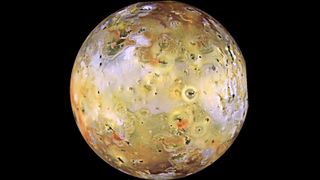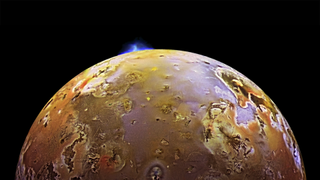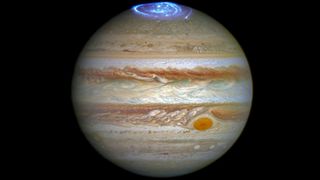Io: A guide to Jupiter's volcanic moon
Explore Io, the most volcanically active body in the solar system.

Io — Jupiter's fifth moon — is the most volcanically active body in the solar system. Io's surface is peppered with hundreds of volcanoes, some spewing sulfurous plumes hundreds of miles high.
The volcanic moon is Jupiter's third-largest and the innermost Galilean satellite, it finds itself caught in a gravitational tug-of-war between Jupiter and two nearby Jovian moons Europa and Ganymede. These tidal forces generate the heat that drives Io's intense volcanic activity, according to NASA.
Io's surface is changing at an incredible rate. Volcanic fissures ooze lava onto the moon's surface, filling impact craters and creating new floodplains of liquid rock. While Io's exact composition is unknown, it is likely molten sulfur and its compounds or silicate rock, according to NASA. Additionally, the moon's thin atmosphere is primarily composed of sulfur dioxide.
Related: 10 incredible volcanoes in our solar system
Io fast facts
- Age: Io is about 4.5 billion years old, about the same age as Jupiter.
- Distance from Jupiter: Io is the fifth moon from Jupiter. Its average orbital distance is about 262,000 miles (422,000 km). Io takes 1.77 Earth-days to orbit Jupiter. Io is tidally locked, so the same side always faces Jupiter.
- Size: Io has a mean radius of 1,131.7 miles (1,821.3 km) making it slightly larger than Earth's moon. It has a slightly elliptical shape, with its longest axis directed toward Jupiter. Among the Galilean satellites, Io ranks third, behind Ganymede and Callisto but ahead of Europa, in both mass and volume.
- Temperature: Io's surface temperature averages about minus 202 degrees Fahrenheit (minus 130 degrees Celsius), resulting in the formation of sulfur dioxide snowfields. But Io's volcanoes can reach 3,000 degrees F (1,649 degrees C). Io is often referred to as a celestial body of fire and ice.
- Distance from Earth: At its closest to Earth, when both Jupiter and Earth are on the same side of the sun, the distance to Io can be as little as 365 million miles (588 million km), according to the space science website The Nine Planets. But at its maximum distance, it can be as far away as 601 million miles (968 million km).
Orbit and volcanism

Io's volcanic activity was first discovered by NASA's Voyager missions in 1979. The moon's volcanism is driven by powerful tidal forces.
As Io orbits Jupiter in an elliptical fashion, the strength of Jupiter's gravity on Io varies depending on how close the moon is to the gas giant. This gravitation fluctuation creates a perpetual push and pull on the moon's interior in different directions, which causes Io's surface to bulge by as much as 330 feet (100 meters), according to NASA. This movement causes Io's rocks to grind past each other, generating vast quantities of heat — 20 times more heat flow than Earth.
If Io were Jupiter's only moon, its orbit would have likely "settled down" into a circle a long time ago, but the ongoing, constant outward tug from Io's outer neighbors Europa and Ganymede ensure that does not happen. Io cannot escape this perpetual game of gravitational tug-of-war and subsequent planetary heating.
Composition
Io's surface is primarily composed of sulfur and sulfur dioxide, according to ESA. Patches of sulfur dioxide frost have also been spotted on the surface, along with hundreds of volcanoes.
Io's sulfur dioxide atmosphere is extremely thin — about one billionth the surface pressure of Earth's atmosphere, according to ESA.
How Io affects Jupiter
Jupiter's moon Io may be small (roughly the size of Earth's moon) compared to the planet (more than 1,300 Earths could fit inside Jupiter), but the moon still has a mighty impact on its parent planet.
Io's orbit cuts across Jupiter's powerful magnetic lines of force, turning Io into an electric generator. According to NASA, Io can develop 400,000 volts across itself, in turn creating 3 million amperes of electrical current. This then makes its way back along Jupiter's magnetic field lines and causes lighting storms in Jupiter's upper atmosphere.
As Jupiter rotates, the magnetic forces strip away about a ton of Io's material every second. The material becomes ionized and forms a doughnut-shaped cloud of radiation called a plasma torus. Some of the ions are pulled into Jupiter's upper atmosphere and create auroras. An example of this activity was spotted by the Hubble Space Telescope, which revealed the influences of Io and another Jovian moon, Ganymede, in Jupiter's auroras in 2018. Further evidence of Io's volcanoes and electric current driving Jupiter's auroras was revealed in a 2022 study.

Io also has a collapsible atmosphere, according to observations from the Gemini North telescope in Hawaii and the Texas Echelon Cross Echelle Spectrograph (TEXES). The sulfur dioxide envelope of gas freezes up while Io is in the shadow of Jupiter every day.
When Io comes back into the sunlight, the freezing sulfur dioxide converts to gas once more. Scientists long suspected this phenomenon exists, but it was only after this study — which saw Io's atmosphere in the dark for the first time — that researchers found confirming evidence.
Discovery and naming
Io was the first of Jupiter's moons discovered by Italian astronomer Galileo Galilei on Jan. 8, 1610. According to NASA, he discovered the moon the day prior, but could not differentiate between Io and Europa, another Jupiter moon, until the next night.
This discovery, along with the discovery of three other Jovian moons, was the first time a moon was ever found orbiting a planet other than Earth. Galileo's discovery eventually led to the understanding that planets orbit the sun, instead of our solar system revolving around Earth.
Galileo first referred to this moon as Jupiter I. In the mid-1800s, the moon was renamed Io. In Greek mythology, Io was a priestess of Hera (Zeus' wife) and the daughter of Inachus, the king of Argos. Zeus (the counterpart for the Roman god Jupiter) fell in love with her but turned her into a cow to avoid being caught with her by his wife, Hera (or Juno).
Missions to Io
While no dedicated mission has been sent to Io, several spacecraft have flown by Jupiter and observed its moons. NASA's Pioneer 10 craft arrived first in 1973, followed by Pioneer 11 in 1974. NASA's Voyager 1 and Voyager 2 probes returned to the system, capturing striking photos during their flybys in 1979.
Between 1995 and 2002, NASA's Galileo spacecraft made multiple flybys of Io and provided us with the closest views to date of the volcanic moon. In 2000, Cassini studied Io during a flyby whilst en route to Saturn.
While there is no mission specifically planned to look at Io, other missions are now in the vicinity of the moon — such as the Juno spacecraft — or will be in future years. The European Space Agency's JUICE mission (Jupiter Icy Moons Explorer), set to launch in 2023, will focus on Europa, Ganymede and Callisto. In 2024, NASA's Europa Clipper mission plans investigate the habitability of another Galilean moon, Europa.
Additional information
Read more about volcanism on Io with San Diego State University. Explore the upcoming Juice mission in more detail with ESA. Learn more about Io with observations made by the Hubble Space Telescope with this ESA article. Discover Io’s tidal heating processes with this infographic from NASA.
Bibliography
McEwen, Alfred S., et al. "The lithosphere and surface of Io." Jupiter: The Planet, Satellites and Magnetosphere (2004): 307-328.
Tsang, Constantine CC, et al. "The collapse of Io's primary atmosphere in Jupiter eclipse." Journal of Geophysical Research: Planets 121.8 (2016): 1400-1410.
Lopes, Rosaly MC, and John R. Spencer. Io after Galileo: A new view of Jupiter's volcanic moon. Springer Science & Business Media, 2007.
Bagenal, Fran, and Vincent Dols. "The space environment of Io and Europa." Journal of Geophysical Research: Space Physics 125.5 (2020): e2019JA027485.
Thomas, Nicolas. "A comprehensive investigation of the Galilean moon, Io, by tracing mass and energy flows." Experimental astronomy (2021): 1-17.
Join our Space Forums to keep talking space on the latest missions, night sky and more! And if you have a news tip, correction or comment, let us know at: community@space.com.
Get the Space.com Newsletter
Breaking space news, the latest updates on rocket launches, skywatching events and more!

Daisy Dobrijevic joined Space.com in February 2022 having previously worked for our sister publication All About Space magazine as a staff writer. Before joining us, Daisy completed an editorial internship with the BBC Sky at Night Magazine and worked at the National Space Centre in Leicester, U.K., where she enjoyed communicating space science to the public. In 2021, Daisy completed a PhD in plant physiology and also holds a Master's in Environmental Science, she is currently based in Nottingham, U.K. Daisy is passionate about all things space, with a penchant for solar activity and space weather. She has a strong interest in astrotourism and loves nothing more than a good northern lights chase!
- Elizabeth HowellStaff Writer, Spaceflight
- Kim Ann ZimmermannSpace.com Contributor
